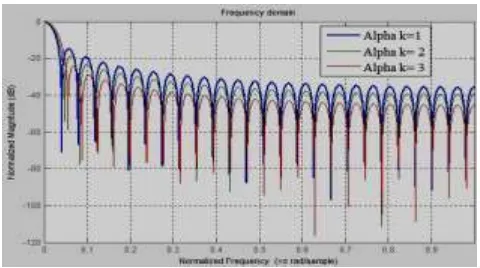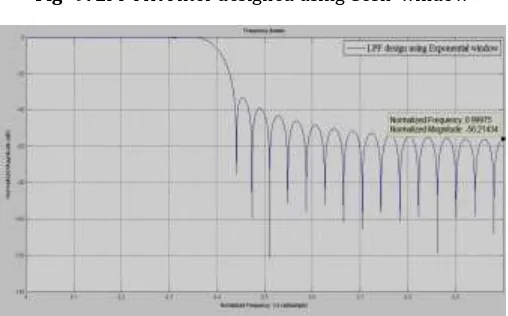Comparative Study of Sidelobe Roll-Off Ratio for Various Window
Functions and its Application
Ravi Rastogi
1, Ritesh Pratap Rao
2, Shalinee Mishra
3 1Scientist C, NIELIT Gorakhpur, Uttar Pradesh, India
2Scientist B, NIELIT Gorakhpur, Uttar Pradesh, India
3
Scientist B, NIELIT Gorakhpur, Uttar Pradesh, India
---***---Abstract - This paper is based on comparison of sidelobe
roll-off ratio for Kaiser, Cosh and Exponential window. In filter designing application, higher the sidelobe roll-off ratio, higher will be the far-end stopband attenuation for any FIR filter. Simulation results show that the Exponential window provides highest sidelobe roll-off ratio as compared to Kaiser and Cosh window functions. A low pass FIR filter is designed using Kaiser, Cosh and Exponential window. It is shown that the low pass filter designed using Exponential window function provides maximum far-end stop band attenuation than the filters designed using other window functions.
Key Words: Sidelobe roll-off ratio, window function, Filter Design, FIR filter, Attenuation.
1. INTRODUCTION
The major applications of window functions in signal processing are signal analysis and estimation, digital filter design and speech processing [1-2]. Many windows have been proposed in literature [3-6]. The important parameters of window function are ripple ratio, sidelobe roll-off ratio, main lobe width etc. Among these parameters, sidelobe roll-off ratio is an important parameter. In [6] it is shown that for beamforming applications, far end interferences can be rejected by higher sidelobe roll-off ratio.
In filter design applications, it can reduce the far end attenuation for stopband energy and for speech processing, it reduces the energy leak from one band to another [7]. Kaiser window is a well-known flexible window and widely used for FIR filter design and spectrum analysis applications [2-3] as it achieves close approximation to the discrete prolate spheroidal functions that have maximum energy concentration in the main lobe. By adjusting its two independent parameters, namely the window length and the shape parameter, it can control the spectral parameters main lobe width and ripple ratio for various applications. Kaiser window has a better sidelobe roll-off characteristic than the other well-known adjustable windows such as Dolph-Chebyshev [4] and Saramaki [5], which are special cases of ultraspherical window [6]. In this paper comparison of spectral parameter namely sidelobe roll of ratio of Kaiser, Exponential and Cosh has been done.
It is shown that the Exponential window function provide maximum sidelobe roll-off ratio as compared to other window functions. Also, the FIR filter designed using
Exponential window provides maximum far-end stop band attenuation as compared to the FIR filter designed using other window functions.
2. SPECTRAL PARAMETERS OF WINDOW FUNCTIONS
A window function w(nT) having a length N is defined as:
1
2
,
(
) /
(
)
,
nonzero
n
N
w nT
zero
otherwise
Windows are generally compared and classified in terms of their spectral characteristics. The frequency spectrum of w(nT) can be found in [8].
( 1)/2 ( )
1
( ) ( ) (0) 2 ( ) cos( )
n
jwT j w
n
W e A w e w w nT wnT
where T is the sample period. A typical window has a normalized amplitude spectrum in dB as shown in Figure
Fig-1: A typical window’s normalized amplitude spectrum
Normalized spectrum in (1) can be obtained from
( ) / ( max
log 20 )
(e Aw A w
W jwT
The common spectral characteristic parameters that distinguish windows performance are the mainlobe width , ripple ratio (R) and sidelobe roll-off ratio (S). From Figure 1, these parameters can be described as
Two times half mainlobe width = .
R = Maximum sidelobe amplitude in dB - Mainlobe amplitude in dB = S1.
S = Maximum sidelobe amplitude in dB - Minimum sidelobe amplitude in dB = S1-SL.
In some applications, it is desired that a window should have smaller ripple ratio and narrower mainlobe width but this requirement is contradictory [1]. Because to reduce main-lobe width the window length should be increased which further increases ripple ratio. So there is a trade-off between these two parameters.
3. VARIOUS WINDOW FUNCTIONS
3.1 Kaiser window
In discrete time domain, Kaiser window is defined by [3]
otherwise N n I N n I n w k k k , 0 2 1 , ) ( 1 2 1 ) ( 0 2 0
where is the adjustable shape parameter, and is the modified Bessel function of the first kind of order zero and it is described by the power series expansion as
2 1 0 2 ! 1 1 ) (
k k x k x I [image:2.612.332.571.268.436.2]The frequency domain characteristics of Kaiser window is shown in Figure 2. It can be seen that the main-lobe width increases and ripple ratio becomes smaller as we increase the value of .
Fig-2: Frequency domain representation of Kaiser window.
3.2 Exponential window
The functions exp(x) and have the same shape
characteristic. Therefore, a new window, namely exponential window, can be proposed [9]:
otherwise N n N n n w k k k , 0 2 1 , ) exp ( 1 2 1 exp ) ( 2
Where is the adjustable shape parameter and exp (x) is exponential function. The frequency domain representation of exponential window is shown in Figure 3 for different values of
Fig -3: Frequency domain representation of exponential window.
3.3 Cosh window
The hyperbolic cosine of a variable x is expressed as [8]
2 ) cosh( x x e e x
The functions cosh(x) and have the same shape characteristic. Therefore, a new window, namely Cosh window, can be proposed as
otherwise N n N n n w k k k , 0 2 1 , ) cosh( 1 2 1 cosh ) ( 2
[image:2.612.48.288.576.710.2]Fig -4: Frequency domain representation of Cosh window.
SIDE LOBE ROLL-OFF RATIO COMAPRISION BETWEEN
KAISER,COSHANDEXPONENTIALWINDOW
Side lobe roll-off ratio for Kaiser, Cosh and Exponential window are calculated for window length N=51, main lobe
width .40 rad/sample and same value of parameter .
It is seen that for the same value of parameters the Exponential window provides maximum side lobe roll-off ratio, while Kaiser window provides minimum Side lobe roll-off ratio. Table I illustrates the result for the given data.
TABLE -1:Data for comparison between Kaiser, Cosh And Exponential window
Window
k
N Sidelobe roll-off ratio S (dB)
Mainlobe width
M
W (rad/sample)
Kaiser 2 51 20.77 .039
Cosh 2 51 21.84 .041
Exponential 2 51 32.94 .042
[image:3.612.317.578.78.251.2]The Figure 5, 6, and 7 show the sidelobe roll-off ratio for Kaiser, Cosh and Exponential window functions.
[image:3.612.314.575.279.426.2]Fig -5: Sidelobe roll-off ratio for Kaiser window
Fig -6: Sidelobe roll-off ratio for Cosh window
Fig -7: Sidelobe roll-off ratio for Exopnential window
FIRFILTERDESIGNUSINGWINDOWMETHOD
5.1 Window design method
To design FIR filters we use Fourier series method with windowing. This technique is straightforward and requires a minimal amount of computation compared to the optimization methods. In Fourier series method Window function is used to truncate and smooth the infinite duration impulse response of the ideal prototype filter. The impulse response of a realizable noncasual FIR filter using a window function, w(nT ), is obtained as [8].
)
(
)
(
)
(
nT
w
nT
h
nT
h
nc
id Where
(
)
id
[image:3.612.49.292.414.541.2] [image:3.612.43.294.584.716.2]0
0
/ ,
( ) sin
,
ct
id ct
w T for n h nT w nT
for n n
Delaying the noncausal impulse response hnc(nT)by a duration (N1) / 2, a casual filter can be obtained as
n N T
h nT
h( ) nc 1/2 .
The ripples in both passband and stopband regions of the filters designed by the window method are approximately equal to each other [6].
5.2 Comparison of FIR filter design by various windows
For designing of low pass non recursive filter we need to define following specifications:
Sampling frequency: (radian/sample).
Order of the filter: N.
Normalise cutoff frequency: (radian/sample).
Type of window used.
Main lobe width.
Here an example is being analyzed, which shows that the FIR Filter designed by Exponential window provides the better far end stop band attenuation (maximum stop band attenuation) than the filter designed by the well known Kaiser window and Cosh window, which is the figure of merit. The specifications for designing a low pass FIR filter by exponential window are: Order of the filter (N=51), Normalized cutoff frequency: = 0.4 rad/sample and = 2. The results of FIR filter designed by Exponential window with the FIR filter designed by Kaiser and Cosine hyperbolic windows were compared. For the above example, we find the various spectral parameters as listed in Table II.
TABLE -2:Data for LPF design using window functions
S.No Parameters Kaiser Cosh Exponential
1 c .4 .4. .4
2 k 2 2 2
3 N 51 51 51
4 WM .77 .77 .77
5 FSA -48.17 -52.45 -56.21
From Table II we can see that the filter designed by Exponential window provides better far end stop band attenuation than filter designed by Kaiser and Cosh window.
This is the greatest advantage of filter designed by the Exponential window than that designed by Kaiser and Cosh Window.
[image:4.612.312.588.176.335.2]The frequency response of filters designed by Kaiser, Cosh, and Exponential Windows are shown in Figure 8, 9 and 10 respectively.
Fig -8: LPF FIR Filter designed using Kaiser window
Fig -9: LPF FIR Filter designed using Cosh window
[image:4.612.315.574.367.520.2] [image:4.612.318.572.539.697.2]6.APPLICATIONSOFHIGHSIDELOBEROLL-OFFRATIO
In Beamforming applications, the higher sidelobe roll-off ratio results in better rejection of the far end interferences [2]. In filter design applications, it reduces the far end attenuation for stopband energy [7] which can be used in sub-band coding and speech processing applications. For Speech processing applications, it reduces the energy leak from one band to another [8].
7.CONCLUSION
In this paper the spectral properties of different window functions have been studied. Sidelobe roll-off ratio is calculated for a given specification for Kaiser, Cosh, and Exponential window. The simulation results show that the Kaiser window provides lowest sidelobe roll-off ratio while Exponential window provide highest sidelobe roll-off ratio. It is shown that the FIR low pass filter designed using Exponential window function provides highest far-end stop band attenuation than that designed using other window functions. The better far-end stopband attenuation in case of exponential window is its figure of merit.
REFERENCES
A. Antoniou, Digital signal processing: Signal, systems, and filters, McGraw-Hill, 2005.
B. J.F.Kaiser and R.W.Schafer, “On the use of the Io-sinh window for spectrum analysis” IEEE Trans. Acoustics, Speech, and Signal Processing, vol.28, no.1, pp. 105-107, 1980.
C. I. J. F. Kaiser, “Nonrecursive digital filter design using I0-sinh windowfunction” in Proc. IEEE Int. Symp. Circuits and Systems (ISCAS’74),San Francisco, Calif, USA, pp.20-23, April 1974.
D. C. L. Dolph, “A Current Distribution for Broadside Arrays Which Optimizes the Relationship Between Beamwidth and Side-lobe Level” Proc. IRE, vol.34, pp.335-348, June 1946.
E. A. T. Saramaki, “A class of window functions with nearly minimum sidelobe energy for designing FIR filters” in Proc. IEEE Int. Symp. Circuits and systems (ISCAS’89), Portland, Ore, USA, vol.1, pp. 359- 362, 1989.
F. S. W. A. Bergen and A. Antoniou, “Design of ultraspherical window functions with prescribed spectral characteristics” EURASIP Journal on Applied Signal Processing, no.13, pp. 2053-2065, 2004.
G. A. Jain, R. Saxena and S. C. Saxena, “A simple alias-free QMF system with near-perfect reconstruction” J. Indian Ins. Sci., Jan-Feb, no.12, pp. 1-10, 2005.978-1-
H. Avci K, Nacaroglu A. Cosine hyperbolic window family with its application to FIR filter design. In: Proceedings of the 3rd international conference on information and communication technologies: from theory to applications (ICTTA’08), Damascus, Syria, 2008. p. 289–90.
I. K.Avci, A.Nacaroðlu, “A New Window Based on
Exponential Function”. Proceedings of 3rd


